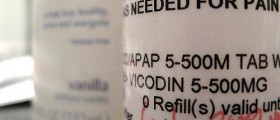Thank you,
from somebody who knows from years of experience
Loading...
Loading...
Oxycodone Hydrochloride IS the MAIN ACTIVE INGREDIENT in OXYCONTIN. Oxycontin is simpy a TIME RELEASE formulation.
Percocet is ALSO Oxycodone HCL, combined with APAP, and in INSTANT RELEASE form. THEY ARE THE SAME DRUG. PERCOCET IS THE SAME DRUG AS OXYCONTIN, PERIOD.
Second, Oxycondone is NOT "synthetic heroin". First of all, Heroin is Semi-synthetic, it is DIACETYL MORPHINE, A modified form of Morphine. Oxycodone is COMPLETELY synthetic, made from Thebaine. Both are totally different from each other.
Third, To the first 'guest', your post is nearly 100% accurate, BUT. You mention a time release COATING. There is no such thing. The time release mechanism is INSIDE the pill, mixed evenly into the matrix. In NAME BRAND Oxycontin (not the generic) the time release is WAX based. The coating on ANY tablet or pill is simply to identify the pill with a color, and in some cases to protect the pill from the elements (AIR, Light, etc..)
You guys think its no big deal but you can really get someone hurt spreading inaccurate information about drugs, so if you dont know what you are talking about.
Loading...
Loading...
The truth is that you can create an addiction to any narcotic medications, but if you take hydrocodone and it doesn't work you are more than likely to take more and more until you are taking 10 to 20 a day. You may say no that won't happen to me, but I have seen it in my profession to so many people that never saw it coming. My advice is to talk to your doctor about the strongest pain medication that he/she thinks you can handle for your pain. This way whatever you take will last for a longer period of time and you wont be tempted to take more and more to get relief. Hope I was able to help.
Loading...
worse over the years,to the point i couldn't get out of bed.they found out not long ago what was wrong with my back so they started trying me on 10 different meds and nothing was working.i was in such pain i would lay onthe floor with my legs on the bed crying and my chest even hurt from all the pain.finally they put me on lortab 10mg twice a day and it was like a miracle.well about 2 months ago my vision wqas staying blurry and i was dizzy and sick.i also was stubling.so i went back to the doc.my blood pressure was high.oh i had been having severe migranes everyday and night as well so he took me off and put me on a patch called something like duragesic 50 mcg/fentadol or something.welli i stoped having migranes and blood pressure got normal but the patches didn't help my pain so i had to call in and he called me in the lortabs again till i see him tommorow.with all that being said i have been wanting to know if oxycottin would be strong enough to help my back pain or atleast as strong as a 10 mg lortab without the migranes?i take 3 a day and i cant take the migranes anymore and im eating more goddys powders than i can afford.thanks for ant help you guys might have.note,this is a family pratice doc and not a pain management doc so im lucky to have gotten this far.
Loading...
Loading...
Loading...
Loading...
By the way, Vicodin, Lortab, Lorcet and Norco are all Hydrocodone/APAP combinations. The only difference between the four of these is the amount of APAP or tylenol that is in the mixture. Vicoprofen is the only hydrocodone/ibuprofen combination that is in the US. All medications are scaled to the strength of morphine. Tramadol is Ultram or Ultracet. Dextropropoxyphene is the active ingredient in Darvon, Darvocet. Hydrocodone is Vicodin, Lortab, Lorcet and Norco. Oxymorphone is Opana. Oxycodone is Percocet, Oxycontin, Roxicodone, Roxicet. Hydromorphone is Dilaudid. Morphine is the active ingredient in Avinza.

Loading...
A reply to Guest's remarks about Oxycontin being synthetic heroin and much stronger than Percocet: contrary to what many people think, Oxycontin is the exact same drug as oxycodone, only with a time-release coating. Oxycodone (or oxycodone combos such as Percodan/Percocet, which combine oxycodone w/ asprin or Tylenol) is faster acting and immediately digested and released into the body, while Oxycontin is released slowly into the body over a longer period of time. Oxycodone (or Percocet) is for immediate relief of pain, or breakthrough pain, while Oxycontin is used for chronic, long-lasting pain. The main advantage with Oxycontin is that you don't have to remember to take many pills over an entire day at consistent time intervals, as with the immediate-release pills. This is the only difference between OxyCONTIN and OxyCODONE. Everyone: please be careful when giving people advice about medications if you don't know exactly what you're talking about, because it sounds like Guest was guessing and/or making assumptions, which can be very dangerous when you're dealing with powerful drugs such as opioids.
i probably know more about this stuff than anyone on this site and i dont even have a perscription to the sh*t, oxycottin is just slang for oxycodone, and yes oxycodone is much stronger than hydrocodone. i dont care what anyone says i have experimented with both and i have found out for myself, and yes the withdrawl is horrible. im glad i quit. but i was takin 30 mg of hydrocodone just to get high back in the day and the i switched to oxycottin and i only needed like 10 mg's of it to get high. then i made my way up to 30 mg's just to get high and thats when i admited i had a problem and got help
Loading...
After being on pain killers for over 10 years now (Oxycontin & Oxycodone) I just want to say..be careful with them. I have multiple injuries that are inoperable and I am on 'palative care! Dying a little quicker than most! I sometimes hate them but they are a necessary evil if I am to function! My current dose is 240mg/day, 60mg QID, (4x15mg oxycondone) that is a lot and they are not doing the job anymore like they used to but I am not sure more is the answer. I am turning 60 and just want to be able to get around, so like I said, be careful with your medication regardless of what is prescribed! It's so easy to take a few more!
Take care
Crusty
Loading...
actually you can bypass the time release on an opana seen it done many times either scrap it off or wet it and rub it off and then its immediate release,but this is very dangerous!!!Guest wrote:
To the guest with inaccurate info: You too should do your research before posting some one else is wrong. Oxycodone HCL is a time released drug, Oxycodone is not. You really should be careful about what you write as well.
I hate to break it to u but Oxcontin and Oxycodone are not the same drug, yes they are in the same family and yes they carry VERY similar chemical structures but NO they are not the same drug. Oxycodone is made by ENDO and Oxycontin is not. There was a huge battle when ENDO put out OPANA because its time release structure was alleged to be a copy of Oxycontins, where as in fact they are not. Oxycontin's time release properties are very easy to bi-pass where as OPANA can only be absorbed at a stronger rate but it takes stomach acid to activate the time release. So it will always be a time released drug and many patients like myself have been switched over to it. To make sure there's no confusion here OPANA is oxymorphone which is two times stronger per miligram than Oxycodone which is why the OPANA ER's will never be approved by the FDA stronger than 40mg at the max dose twice a day.
Now to validate myself I have the genetic pre-disposition for Degenerative Disc Disease and developed my first at age 13. I now have 8, 3 pinched nerves, spinal stenosis, spinal trauma from a car accident and the list goes on. I've been on every drug you can think of as I've been in and out of pain management now for 6 years and before that was on everything out there to keep me from pain management.
Hydrocodone comes in two forms Hydrocodone and Hydrocodine basically in lamens terms...Vicodin and lortab. They are made with out tylenol and with out ibuprofen one is called NORCO. Where as Oyxcodone is made without asprin one is called Roxicodone not to be confused with Roxicet or Endocet which are other forms of the oxycoedine strand but my knowledge of them is not good enough to preach about.
1mg of Hydrocodone is equal to .5 miligrams of oxycodone
1mg of Oxymorphone is equal to .5 miligrams of Oxycodone
oxymorphone is the nicer brother of hydromorphone(dilaudid) which is the strongest pain killer approved by the FDA Dilaudid guarantees addiction in its 3rd dose. shall I continue? or have I made my point that the info is out there just get on actual research or pharmaceutical sites. Or read ur labels on the ur Walgreens bags. sorry if this sounds mean Im just frustrated I'm not mad at anyone on here so dont think I'm being an ass. I'm just mad cuz I'm in pain constantly. oh and Im' goin to excuse any of my typos now as one wonderful side effect of opiates is vision disturbance
Loading...
I found this discussion well intended but misleading on many levels, and not surprisingly so, given the social stigmas surrounding the topic. I practiced anesthesia for 27 years, about 10% of my patients had chronic pain from a variety of causes, including cancer, orthopedic problems, post spinal fusion and other conditions. 15 years ago I suffered a spinal injury, to continue practicing anesthesia, I got by for several years on a variety of non-narcotic analgesics, but eventually deterioration of the affected area resulted in a five level spinal fusion. At which time I had to give up anesthesia and join the ranks of a healthcare recipient rather than a provider. I have been taking narcotics on a daily basis now for 9 years, so I have a point of view from both sides of the isle and I can assure everyone, there are no hard cold facts that conveniently lump every drug or every patient into neat little categories when answering the question, what will work best for my needs?
It is difficult at best, to find objective and open minded healthcare providers to manage chronic pain because of social stigmas, pressures from government regulators and peers, so in healthcare today, it is truer than ever, that the adage buyers beware; should be employed by all consumers. There is no substitution for educating yourself about options and your rights when seeking a treatment or a provider for chronic pain issues.
For the sake of study and as a guide for prescribers, labeling one drug stronger or more effective in managing pain for a given condition is all relative at best. The literature exists to provide comparative guidelines and as a starting point in chronic pain management only, nothing more. Measuring a drugs appropriateness for a particular type of pain, cause by a specific type of condition from the perspective of its addictive properties, chemical properties, or method of delivery, is like trying to compare apples, oranges and pears and then claiming one is better than the other when it comes adding fruit to your diet.
The single most important criteria for measuring the efficacy of a particular drug for an individual is the clinical outcome from the patient’s use of the medication, end of story… I have provided anesthesia to numerous patients with dosage amount 1/50 of what I would typically use for most patients, and on other occasions I have almost emptied the drug cabinet trying to hold a patient still on the table. Neither one of these outcomes tells you anything other than, one patient had a higher pain tolerance than the other and the debate over why one would be different from the other; is a moot point. At the end of the day, the patient owns their pain, not the provider, caregiver, insurance company or anyone else, so it is up to no one but the patient to determine what works and what doesn’t. A good healthcare provider recognizes this and positions him/herself as a partner with the patient in the choice of treatment for a given need.
So, to ashli, who originally started this thread, the answer is simply, find what works and go with it, if that is aspirin then great, if it takes something stronger, work your way up until you find something that works, how your body reacts will determine what is right for you. It is not unusual to try several different medications and treatment plans before finding something that works, and by all means, do not let others determine your reality for you. Find a provider you trust, one who truly has a desire to partner with you in your efforts to get the best care and outcome available. And when weighing the risks and side effects, understand that few medications and treatment plans carry with them no risk and no side effect, there will always be some level of acceptance you must practice and some adjustments you must make to find a balance between your illness and your quality of life.
Loading...















_f_280x120.jpg)
